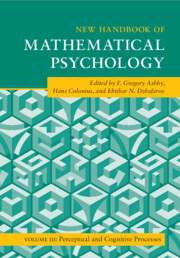Book contents
- Frontmatter
- Contents
- Contributors
- Preface
- 1 Principles and Consequences of the Initial Visual Encoding
- 2 Measuring Multisensory Integration in Selected Paradigms
- 3 Fechnerian Scaling: Dissimilarity Cumulation Theory
- 4 Mathematical Models of Human Learning
- 5 Formal Models of Memory Based on Temporally-Varying Representations
- 6 Statistical Decision Theory
- 7 Modeling Response Inhibition in the Stop-Signal Task
- 8 Approximate Bayesian Computation
- 9 Cognitive Diagnosis Models
- 10 Encoding Models in Neuroimaging
- Index
2 - Measuring Multisensory Integration in Selected Paradigms
Published online by Cambridge University Press: 20 April 2023
- Frontmatter
- Contents
- Contributors
- Preface
- 1 Principles and Consequences of the Initial Visual Encoding
- 2 Measuring Multisensory Integration in Selected Paradigms
- 3 Fechnerian Scaling: Dissimilarity Cumulation Theory
- 4 Mathematical Models of Human Learning
- 5 Formal Models of Memory Based on Temporally-Varying Representations
- 6 Statistical Decision Theory
- 7 Modeling Response Inhibition in the Stop-Signal Task
- 8 Approximate Bayesian Computation
- 9 Cognitive Diagnosis Models
- 10 Encoding Models in Neuroimaging
- Index
Summary
The investigation of processes involved in merging information from different sensory modalities has become the subject of research in many areas, including anatomy, physiology, and behavioral sciences. This field of research termed "multisensory integration’’ is flourishing, crossing borders between psychology and neuroscience. The focus of this chapter is on measures of multisensory integration based on numerical data collected from single neurons and in behavioral paradigms:spike numbers, reaction time, frequency of correct or incorrect responses in detection, recognition, and discrimination tasks. Defining that somewhat fuzzy term, it has been observed that at least some kind of numerical measurement assessing the strength of crossmodal effects is required. On the empirical side, these measures typically serve to quantify effects of various covariates on multisensory integration like age, certain disorders, developmental conditions, training and rehabilitation, in addition to attention and learning. On the theoretical side, these measures often help to probe hypotheses about underlying integration mechanisms like optimality in combining information or inverse effectiveness, without necessarily subscribing to a specific model.
Keywords
- Type
- Chapter
- Information
- New Handbook of Mathematical Psychology , pp. 42 - 79Publisher: Cambridge University PressPrint publication year: 2023

